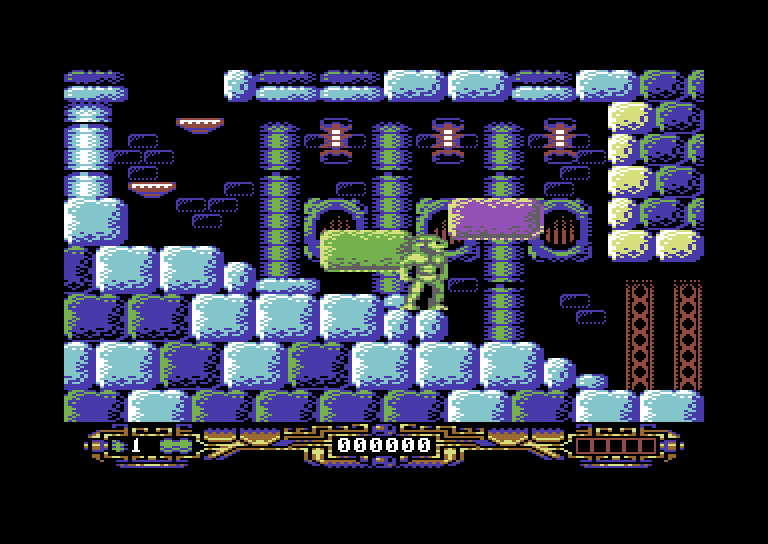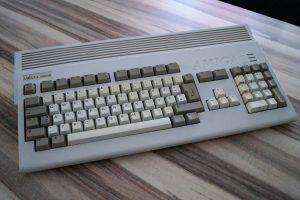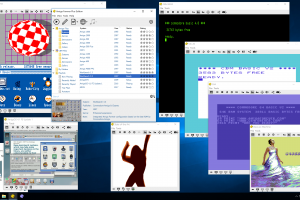Over the past several years, there has been a renaissance of sorts in the Commodore 64 homebrew community, with regular releases of commercial quality games on cartridge. Whether it’s with graphics, like with C64anabalt (2011, Paul Koller), which looks nearly as good as the modern mobile and Flash game, Canabalt (2009, Adam Saltsman), which it’s officially converted from, or with audio, like the haunting soundtrack in Fairy Well (2012, Wide Pixel Games), which proves the enduring timeliness of the Commodore 64’s SID Programmable Sound Generator chip as a unique instrument, these new homebrews easily equal the production quality of the best releases during the platform’s commercial prime in the mid-1980s.
One of the more high profile of this new batch of releases is Soulless, a “Metroidvania” (in the style of Metroid and Castlevania) adventure platformer, though its actual inspirations are Impossible Mission (1984, Epyx) and Draconus (1988, Zeppelin Games). It’s from the former game that Soulless gets its mostly non-violent, somewhat puzzle-centric gameplay, while from the latter it gets its aesthetics.
Soulless opens powerfully enough, with a story told through animated cutscenes backed by a dramatic musical score. The premise is that a powerful warrior king, Rizek, brings peace to his land, which does not sit well with his generals. The generals enlist the aid of an evil wizard who curses the king, stealing his soul and twisting his image into that of a beast. The cursed king is locked away for a thousand years as unending war ravages the land. Finally, one day, a great quake shakes the land and smashes Rizek’s tomb. Now free, you take control of the cursed king as you attempt to reclaim his soul and once again bring peace to the land.
It’s a suitable premise for a game, with the graphics and music of the cutscenes well rendered. Unfortunately, there are a few typos in the text, along with some missing punctuation. While certainly not a deal breaker, between that and the same types of issues in the printed materials, slightly disappointing in the context of an otherwise stellar homebrew package.
The object of the game is simple, collect 12 randomly dispersed spirit stones and place them in the correct order in the Soul Chamber. You accomplish this task by exploring dozens of lushly illustrated temple rooms to the beat of continuous background music and sparse, but effective sound effects.
With the joystick plugged into port 2 on the Commodore 64, the fire button jumps, pulling down crouches and activates spawn points, which also heal you, and pushing up searches an object. While Rizek has no offensive moves, he can uncover helpful items, including gold and rubies for points, magic that either destroys all enemies (red), slows down enemies (green), or freezes enemies (blue), potions that heal, and stone amulets that provide temporary invincibility. Finally, certain doors require finding keys to open.
Besides environmental hazards, like falling stones, Soulless is filled with a wide variety of flying, floating, running, crawling, and shooting enemies that all must be avoided. Each screen has no lack of challenge. Because Rizek’s jump distance is always a fixed length, Soulless forces you to get creative when landing on certain platforms. Unfortunately, it’s this fixed jump mechanic and sometimes all-too-specific landing spots that lead to the greatest frustration with the game. For greater accuracy, a soft touch and a joystick with a shorter throw distance works better for jumping than a looser joystick does. This jump mechanic also plays a role in getting past certain obstacles, sometimes requiring alternate plans of attack, and is a puzzle element of its own. If you’re not careful, you can even fall through to a previous screen. Those easily frustrated need not apply!
Soulless is available in a wide range of formats, including 5.25” floppy disk, cassette tape, cartridge, and digital download. Most formats are also available bundled with a companion CD-ROM and combination poster and map, as well as other paper work, though these are also available for purchase separately. For those who own the companion CD-ROM, the digital download files and copies of the printed material are all included, which makes playing in your emulator of choice trivial.
Soulless is both NTSC and PAL compatible, and its joystick-only control means that it’s even playable on the Commodore 64 GS console. The version reviewed came with an internally LED illuminated purple transparent cartridge shell, three printed spirit stone sheets, which are helpful for jotting down the order of the stones, the combination map and poster, stickers, and a companion CD containing 600MB of bonus material. The CD’s jewel case also contains a combination 16 page comic and instruction booklet. Needless to say, it’s quite the formidable retail package.
While the commercial versions of Soulless are well worth checking out, it’s notable that the game has now been made free to download for use in your favorite Commodore 64 emulator. Soulless was tested on a British (PAL) Commodore 64c and an American (NTSC) Commodore 128DCR, as well as in the C64 Forever Plus Edition (2013, Cloanto) emulator package, which was used to capture this review’s screenshots. There were no notable performance variations on any of the test platforms.
If you don’t mind Rizek’s lack of offensive capabilities, the finicky jump mechanic, and puzzle-centric nature of the gameplay, there’s little not to recommend about this polished production. It’s an incredibly challenging action-adventure game that makes a fine addition to the Commodore 64’s immense library.











 Your total news and information resource for all things Science, Technology, Engineering / Mathematics, Art, and Medicine / Health.
Your total news and information resource for all things Science, Technology, Engineering / Mathematics, Art, and Medicine / Health.
Leave a Comment